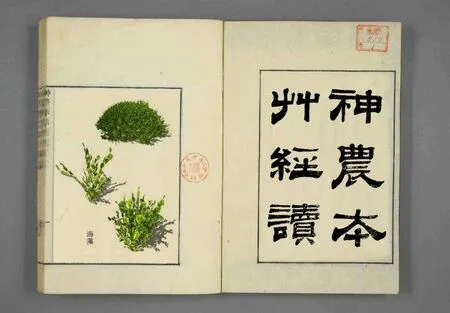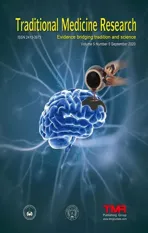Study on an innovative natural drug for Alzheimer's disease reported as a sham
2020-09-03EditorGroupof
Editor Group of

Chinese and English contrastive vocabulary:
Jin Kui Yao Lue:Synopsis of Golden Chamber;Shen Nong Ben Cao Jing:Shennong’s Classic of Materia Medica.
The number of patients with dementia is estimated to be as high as 24 million and is predicted to double every 20 years,i.e.,by 2040,leading to a tremendous financial disease burden [1].Therefore,we urgently need to identify drugs that can prevent,delay the onset,slow the progression,or improve the symptoms of Alzheimer's disease (AD).Drug development for AD has proven to be extremely difficult[2].
A study by Geng Meiyu’s team from the Shanghai Institute of Materia Medica,Chinese Academy of Sciences,in collaboration with Shanghai Green Valley Pharmaceutical Co.,Ltd.,“Sodium oligomannate therapeutically remodels gut microbiota and suppresses gut bacterial amino acid-shaped neuroinflammation to inhibit Alzheimer ’s disease progression,” published in Cell Research on 6 September 2019,revealed the mechanism underlying the inhibitory effect of the novel drug GV-971,a manno-oligosaccharides diacid extracted from the traditional Chinese medicine(TCM)seaweed,on AD [3].Moreover,a randomized,double-blind,placebo-controlled,36-week long phase III clinical trial of GV-971 was successfully completed[3].On November 2,2019,the National Medical Products Administration approved the marketing application for GV-971,manufactured by Shanghai Green Valley Pharmaceutical Co.,Ltd.,for treatment of AD [4].Shanghai Green Valley Pharmaceutical Co.,Ltd.also manufactures the anti-cancer Chinese medicine,China Ganoderma lucidum essence.Advertisements of China Ganoderma lucidum essence claimed to have a killing rate of 93.3% against lung cancer cell lines,94.6% against leukemia cell lines,95.7% against gastric cancer cell lines,and 94.1%against colon cancer cell lines,with an overall response rate of 97% in clinical settings; these inflated numbers caused widespread controversy in China[5].
Seaweed is a TCM with recorded medicinal use in the classical ancient Chinese medicine book entitledShen Nong Ben Cao Jing(Shennong’s Classic of Materia Medica) (25 C.E.-220 C.E.) since long [6].Unlike therapeutic antibodies that confer targeted therapy,GV-971 is a marine oligosaccharide extracted from seaweed.It can bind to multiple fragments of β amyloids (Aβ) at multiple sites,in multiple states,and moreover,can inhibit Aβ fibrils formation,and depolymerize existing Aβ fibrils into non-toxic monomers.Latest research shows that GV-971 can also reduce neuroinflammation in the brain and stop the progression of AD by homeostatic regulation of the intestinal flora and restoration of immune homeostasis[7].
However,the veracity of the GV-971 article was questioned.On November 29,2019,a letter signed by Rao Yi was widely publicized on the internet,which claimed that Rao Yi,president of the Capital Medical University,had issued an authentic report accusing Pei Gang (academic fellow of the Chinese Academy of Sciences),Li Hongliang (dean of the School of Basic Medicine of Wuhan University),and Geng Meiyu(researcher at the Shanghai Institute of Materia Medica,Chinese Academy of Sciences) of academic fraud and called for a formal investigation.On the same day,however,Rao Yi refuted the allegations to the Chinese media [8].Shanghai Institute of Materia Medica,Chinese Academy of Sciences,responded with a statement that Geng Meiyu did not commit academic fraud [9].Interestingly,Rao Yi is also the editor-in-chief of Intellectuals,the well-known WeChat public platform.
The efficacy of natural drugs has been validated in various medical fields.Tu Youyou won the Nobel Prize for the discovery of artemisinin,a TCM with antimalarial property[10].Chen Zhu combined arsenic trioxide (ATO; commonly known as arsenic) with Western medicine to treat leukemia,and the 5-year disease-free survival rate of patients with acute promyelocytic leukemia markedly increased from about 25% to about 95%.This combination therapy is currently the standard treatment for acute promyelocytic leukemia worldwide [11].In the 1970s,Han Taiyun,a pharmacist at the First Affiliated Hospital of Harbin Medical University,accidentally discovered that a prescription containing ATO,mercury chloride,or toad powder had chemotherapeutic effect in some cancer patients;subsequently,he produced an anti-cancer injection by modifying the same ingredients.Professor Zhang Tingdong,a colleague of Han Taiyun,explored the efficacy of preparation containing ATO and mercury on myeloid leukemia.However,because the mechanism of action of ATO was unclear then,the treatment was not used widely [12].However,as early as in the classical ancient Chinese medicine book of TCM entitledJin Kui Yao Lue(Synopsis of Golden Chamber) (25 C.E.-220 C.E.),the use of classic ancient prescription Shengma Biejia decoction,containing arsenic (realgar),has been recorded for the treatment ofYin-Yang toxin,and its manifestation is similar to the purulent infection,one of the representative symptoms of leukemia.As recorded on
Baihe Huhuo Yin-Yang toxin disease,artical 14 ofJin Kui Yao Lue:Yang toxin is a disease that presents red spots on the face that resemble brocades,sore throat,and purulent and bloody exudation during sleep.This condition can be cured within 5 days,but is incurable after the seventh day,and therefore,the Shengma Biejia decoction is recommended for its treatment.In 1877,Nagai Nagayoshi isolated ephedrine from TCM Ma Huang (Herba ephedrae).Chen Kehui proposed that ephedrine has a sympathomimetic effect,which attracted international attention to the drug and set off a wave of research on ephedrine and TCM worldwide.The therapeutic scope of ephedrine quickly shifted from laboratory animal experiments to clinical studies[13].However,the chemical formula of ephedrine closely resembles that of methamphetamine.Methamphetamine can be synthesized from ephedrine through simple processing.Moreover,it has prominent negative effects to the human society.
Citation:
Editor Group of Traditional Medicine Research.Study on an innovative natural drug for Alzheimer's disease reported as a sham.Traditional Medicine Research 2020,5(5):299-301.
杂志排行
Traditional Medicine Research的其它文章
- The marriage of Chinese Imperial Medicine and China Academy of Chinese Medical Sciences:privilege and benefits for the people
- Efficacy and safety of traditional Chinese medicine kidney-nourishing formula for Alzheimer's disease in comparison with donepezil:a systematic review and meta-analysis
- The neuroprotective role of Panax notoginseng saponins in APP/PS1 transgenic mice through the modulation of cerebrovascular
- Ethnoveterinary medicines used against various livestock disorders in the flora of Shamozai Valley,Swat,KP Pakistan
- Molecular mechanism prediction analysis of compound Kushen injection in the treatment of COVID-19 based on network pharmacology and molecular docking
- South Asian medicinal plants and chronic kidney disease
